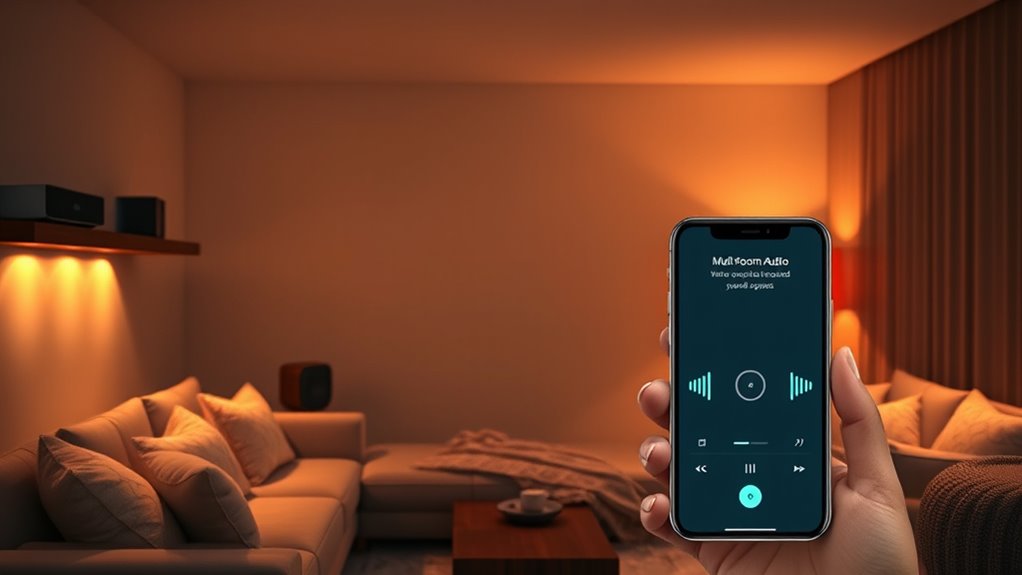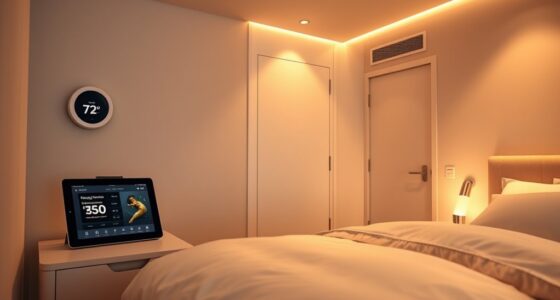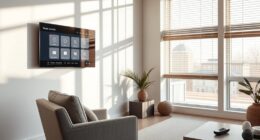To set up multi-room audio for relaxation, start by evaluating your home’s layout and choosing a system that fits your needs. Select wireless or wired speakers that blend with your decor and place them at ear level for the best sound. Connect your devices securely to avoid interruptions, then create custom playlists and sound zones for different moods. Fine-tune your audio for comfort and calmness, and if you keep exploring, you’ll discover how to optimize your entire setup for ultimate relaxation.
Key Takeaways
- Assess each room’s purpose and acoustics to determine optimal speaker placement for a relaxing environment.
- Choose wireless speakers with aesthetic appeal that blend seamlessly with decor and enhance comfort.
- Configure audio zones to play calming playlists tailored to different areas for relaxation.
- Adjust equalizer settings and calibrate sound levels to ensure balanced, soothing sound quality.
- Use acoustic treatments and soundproofing to minimize noise disturbances and improve overall sound clarity.
Assessing Your Home’s Audio Needs and Layout

Before you begin installing a multi-room audio system, it’s essential to evaluate your home’s specific audio needs and layout. Consider how each room’s purpose influences your sound preferences—do you want background music in the living room or focused audio in the home office? Take note of your decorative furniture and interior lighting, as these elements affect speaker placement and acoustic quality. For example, sleek furniture or reflective surfaces might require different speaker positions to optimize sound distribution. Assess the size and shape of each space to determine how many speakers are needed and where they should be installed. This planning guarantees your system blends seamlessly with your interior design and delivers consistent, high-quality audio throughout your home. Additionally, understanding your appliance power requirements can help in planning for any smart home integrations or installations that involve electrical components.
Choosing the Right Multi-Room Audio System

Selecting the right multi-room audio system is key to guaranteeing seamless sound distribution and user convenience. You need a system that matches your existing devices and home setup.
Choosing the right multi-room audio system ensures seamless sound and effortless control throughout your home.
Consider these factors:
- Wireless Compatibility – Ensure the system works with your Wi-Fi or Bluetooth devices for easy streaming.
- Power Requirements – Check if the system needs dedicated outlets or special wiring.
- Scalability – Choose a system that can grow with your needs, adding more zones later.
- Ease of Use – Opt for intuitive control apps or voice assistant integration for effortless operation.
- Organization and Planning – Properly organizing your home’s audio zones and planning the setup can prevent clutter and improve accessibility, making space management more effective.
Selecting Speakers and Placement Strategies

Choosing the right speakers and placing them correctly is key to achieving great sound in your multi-room setup. You should consider ideal locations that distribute audio evenly and select speaker types that suit your space. Proper placement ensures a balanced sound experience across all rooms, enhancing your listening enjoyment. Additionally, considering sound distribution can help optimize the overall audio experience by ensuring consistent sound levels throughout your environment.
Optimal Speaker Locations
To achieve the finest sound quality in your multi-room setup, placing speakers strategically is essential. Proper placement ensures even sound distribution and enhances aesthetic considerations. Think about decorative speaker placement that blends seamlessly into your space without sacrificing sound quality. Here are key strategies:
- Position speakers at ear level for superior audio clarity.
- Use symmetry to create balanced sound across rooms.
- Avoid placing speakers near walls or corners to prevent sound distortion.
- Consider aesthetic considerations by choosing locations that complement your decor.
- Incorporate Kia Tuning principles to optimize both performance and appearance of your audio setup.
Speaker Type Choices
The type of speakers you choose plays a crucial role in achieving high-quality sound throughout your multi-room setup. Decide between wireless vs wired speakers—wireless options offer flexibility and easier installation, while wired speakers can provide more consistent sound quality. Consider portable vs fixed speakers; portable models let you move them easily between rooms, ideal for casual listening, whereas fixed speakers are better for dedicated, permanent setups. Wireless speakers often integrate seamlessly with smart home systems, simplifying control. Fixed speakers, however, may deliver superior sound clarity and volume. Your choice depends on your space, lifestyle, and how much you value convenience versus audio fidelity. Selecting the right combination ensures your relaxation environment sounds balanced and immersive across multiple rooms. Wireless speakers are increasingly popular due to their ease of use and compatibility with smart home systems.
Placement for Sound Balance
Achieving sound balance across multiple rooms depends heavily on strategic speaker placement. Proper placement ensures acoustic balancing and maintains speaker symmetry, creating a seamless listening experience. To optimize your setup:
- Position speakers at ear level for clear audio delivery.
- Maintain symmetry by placing speakers at equal distances from the room’s center.
- Avoid placing speakers near walls or corners to prevent sound distortion.
- Use consistent spacing between speakers to ensure even sound distribution.
- Consider the room’s acoustics and speaker placement strategies to further enhance sound quality.
These strategies help you achieve a balanced soundstage, preventing hotspots or dead zones. Focus on symmetry and acoustic balancing, adjusting speaker locations as needed. Thoughtful placement enhances your multi-room audio system’s overall quality, making relaxation more immersive and enjoyable.
Connecting Your Devices and Network Setup

Setting up your multi-room audio system begins with connecting your devices and establishing a reliable network. Verify all speakers are within Wi-Fi range for ideal wireless connectivity. Use a strong, password-protected network to prevent interruptions. To manage your bandwidth effectively, prioritize audio traffic and limit other device usage during setup. Here’s a simple overview:
| Step | Action | Tip |
|---|---|---|
| 1 | Connect speakers to Wi-Fi | Use 5GHz band for better stability |
| 2 | Check network speed | Ensure sufficient bandwidth |
| 3 | Configure device placement | Avoid interference from walls |
This approach ensures seamless streaming and reduces lag, creating the perfect environment for relaxation.
Configuring Your Multi-Room Audio Software
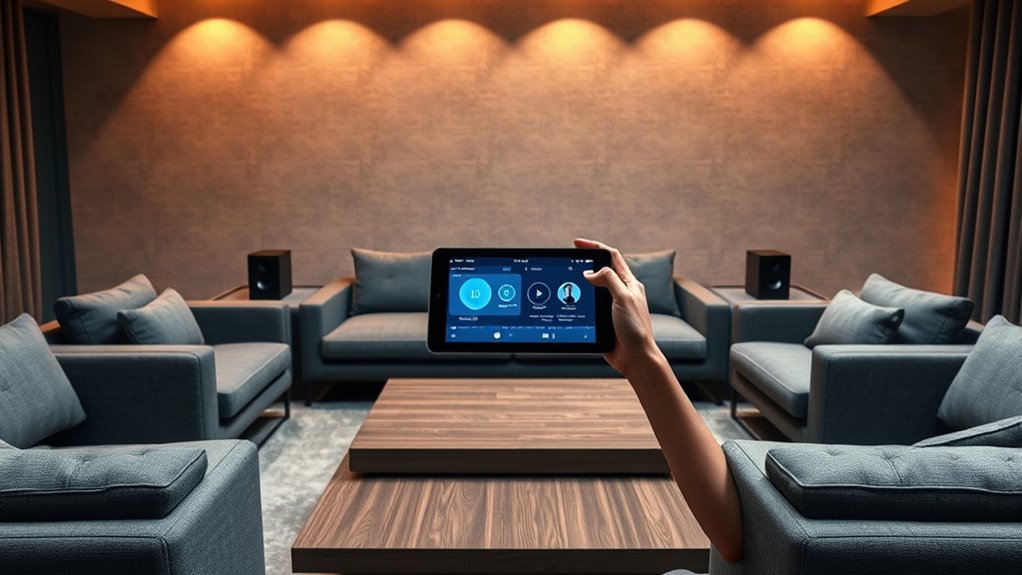
Once your devices are connected to the network, you can begin configuring your multi-room audio software. Start by ensuring all speakers have stable wireless connectivity for seamless playback. Next, perform audio calibration to balance sound levels across rooms, creating a cohesive listening experience. Then, set up your zones by assigning specific speakers to each area, allowing you to control music playback independently. Finally, review the software’s settings to customize volume limits and synchronization preferences. These steps are vital for optimizing your system’s performance and ensuring a relaxing, multi-room audio environment. Proper calibration and network stability are the foundation for effortless control and immersive sound across your space. Additionally, checking for expiration of devices or firmware updates can ensure your system remains secure and functions optimally.
Creating Custom Playlists and Sound Zones
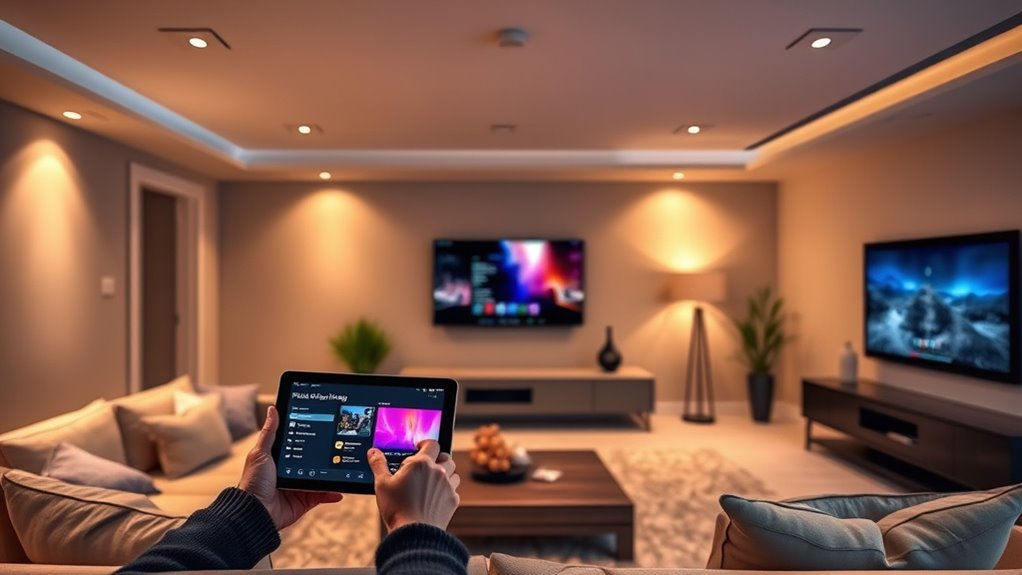
After completing the setup and calibration of your multi-room audio system, you can personalize your listening experience by creating custom playlists and sound zones. Playlist curation allows you to select specific tracks tailored for different moods or activities, ensuring each room plays the perfect ambiance. Sound zoning enables you to designate areas where certain audio settings or playlists apply, giving you control over what each space emits. By organizing playlists for relaxation, focus, or social gatherings, you can easily switch environments without hassle. Adjust sound zones so that each room delivers the desired volume and audio preferences independently. This customization enhances your overall experience, making your multi-room system truly adaptable to your lifestyle and mood. Additionally, integrating automation technologies can streamline your control over sound zones and playlists, allowing for seamless adjustments based on your routines or preferences.
Testing and Troubleshooting the System

Testing your multi-room audio system is a crucial step to guarantee everything functions correctly and sounds just right. Start by checking speaker calibration to ensure each speaker produces balanced sound levels. Next, listen for any interference troubleshooting issues, such as static or dropouts, which may signal signal interference or wiring problems. Being mindful of special occasions can also help you plan for optimal timing and setup to enhance your relaxation experience.
Here are four key steps:
- Play a test track in each zone to verify proper audio distribution.
- Adjust speaker calibration settings for consistent volume and tone.
- Identify and resolve interference sources, like Wi-Fi or other electronics.
- Confirm all devices sync seamlessly, eliminating delays or mismatched audio.
Following these steps helps you troubleshoot common issues, ensuring your multi-room setup delivers relaxing, immersive sound without disruptions.
Tips for Maintaining and Expanding Your Setup
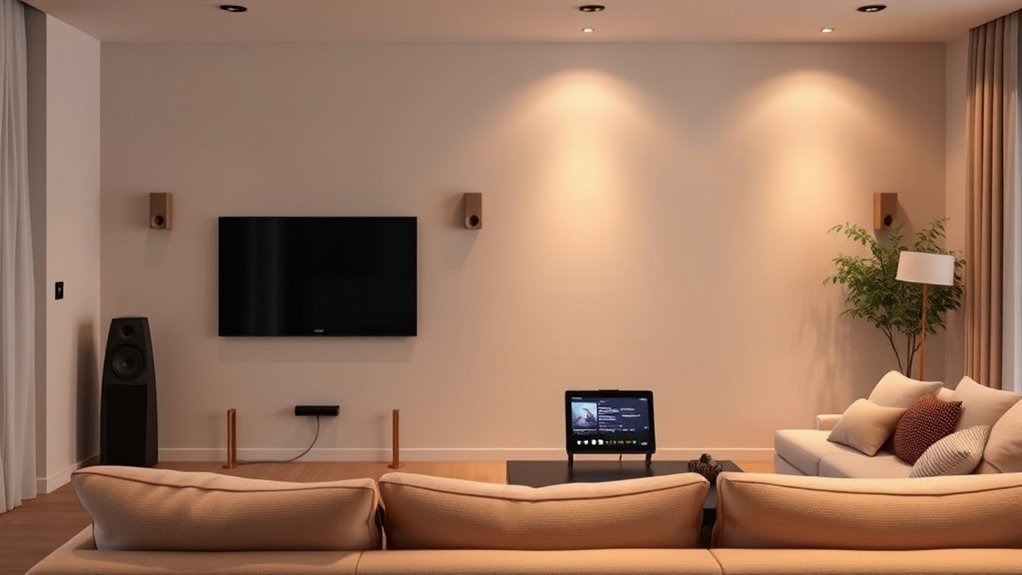
To keep your multi-room audio system running smoothly, it’s important to perform regular checks to identify any issues early. When expanding, make sure to add compatible devices that enhance your setup without causing conflicts. Additionally, fine-tuning your audio settings can optimize sound quality and make certain a seamless listening experience across all rooms. For optimal performance, consider integrating performance upgrades similar to those used in vehicle tuning to ensure your system remains responsive and balanced.
Regular System Checks
Regular system checks are essential to keep your multi-room audio setup functioning smoothly and to identify potential issues before they become major problems. Regularly test speaker calibration to ensure balanced sound across rooms, and check for firmware updates to improve performance and security. These simple steps help maintain audio quality and system stability.
Consider these key actions:
- Verify speaker calibration for even volume and tone.
- Install firmware updates promptly to access new features and fixes.
- Inspect connections and cables for wear or looseness.
- Listen to each zone periodically to catch sound inconsistencies early.
Adding New Devices
Adding new devices to your multi-room audio system can enhance your experience, but it’s important to do so thoughtfully to maintain stability. Before purchasing, check the integration compatibility of new devices with your existing setup. Verify they support the same protocols or platforms to avoid connectivity issues. When adding a device, follow proper device pairing procedures, such as connecting via Wi-Fi or Bluetooth, and confirm that it appears correctly in your control app. Keep firmware updated on both new and existing devices to prevent compatibility problems. Avoid mixing incompatible brands or models that don’t support your system’s standards. By planning your additions carefully, you’ll keep your setup reliable and enjoy seamless multi-room listening without interruptions.
Optimizing Audio Settings
Ever wondered how to get the most out of your multi-room audio system? To optimize your sound, focus on fine-tuning your audio settings and improving your environment. Start with these steps:
- Adjust equalizer settings to enhance clarity and bass, matching your room’s acoustics.
- Use soundproofing techniques like door seals or rugs to reduce outside noise interference.
- Incorporate acoustic treatment options such as wall panels or bass traps to improve sound quality.
- Regularly update your device firmware and app settings for ideal performance.
These adjustments help maintain sound consistency and expand your setup seamlessly. Proper acoustic treatment minimizes echo and distortion, ensuring your relaxation space sounds perfect, no matter how many rooms you expand into.
Enhancing Relaxation With Optimal Audio Settings

Creating an ideal environment for relaxation hinges on selecting the right audio settings. Start with precise audio calibration to guarantee sound quality is balanced across all rooms, eliminating harsh or muffled tones. Adjust volume levels so that music feels immersive but not overpowering. Pay attention to speaker aesthetics—well-designed speakers not only look good but also influence sound dispersion, enhancing the overall experience. Use equalizer settings to soften sharp frequencies and emphasize calming sounds like nature or ambient music. Properly calibrated audio creates a seamless listening environment, making it easier to unwind. When your speakers blend with your space’s decor and the sound is tuned for comfort, relaxation becomes effortless. The right combination of calibration and aesthetics transforms your multi-room system into a sanctuary.
Frequently Asked Questions
How Do I Ensure My Wi-Fi Network Supports Multi-Room Audio Streaming?
To guarantee your Wi-Fi network supports multi-room audio streaming, check that your Wi-Fi bandwidth is sufficient for multiple devices streaming simultaneously, ideally with a strong, stable connection. Also, enhance network security by updating your router’s firmware and using strong passwords. This helps prevent interruptions and unauthorized access, ensuring smooth, reliable audio playback across all rooms. A robust, secure network is key to seamless multi-room audio experiences.
Can I Integrate My Existing Smart Home Devices With the Multi-Room System?
Did you know over 70% of smart home owners want seamless device integration? You can definitely integrate your existing smart home devices with your multi-room system, making control effortless. Confirm your devices are compatible via smart home integration platforms like Alexa or Google Home. This way, your voice assistant compatibility allows you to manage all your audio zones easily, creating a unified, relaxing environment with minimal effort.
What Is the Average Cost for a Reliable Multi-Room Audio Setup?
When considering the cost for a reliable multi-room audio setup, you should think about your budget considerations and compare different brands. On average, expect to spend between $300 and $1,500, depending on the quality and features you want. Higher-end brands offer better sound and smart integrations, but budget-friendly options can still provide a good experience. Comparing brands helps you find the best value for your needs.
How Do I Prevent Audio Lag Between Different Rooms?
To prevent audio lag between rooms, you should address sync issues and minimize audio buffering. Make sure all your devices are connected to a stable Wi-Fi network and update their firmware regularly. Use a wired connection if possible, as it reduces latency. Some multi-room systems have built-in sync settings; enable these features to keep audio perfectly aligned across rooms and avoid frustrating delays.
Are There Eco-Friendly or Energy-Saving Options for Multi-Room Audio Systems?
Think of eco-friendly options for your multi-room audio system as seeds that grow sustainability. You can choose devices with energy-saving features like low power consumption and automatic shut-off. Look for systems with eco-friendly options, such as recyclable materials and energy-efficient technology. These choices help reduce your carbon footprint while delivering great sound. Making smart, energy-conscious decisions guarantees your home stays green without sacrificing audio quality.
Conclusion
Setting up multi-room audio can considerably enhance your relaxation experience. Did you know that a well-designed sound environment can reduce stress levels by up to 65%? By carefully evaluating your space, choosing the right system, and fine-tuning your settings, you create a calming atmosphere tailored to your preferences. Keep maintaining and expanding your setup to enjoy seamless, immersive soundscapes that turn your home into a peaceful retreat whenever you need it.
